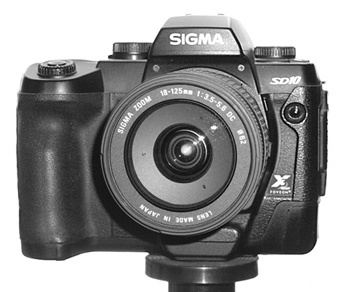ASA/ISO range 100–1600 in 1 EV steps | ||
 | ||
Sensor 20.7 mm × 13.8 mm Foveon X3 sensor Maximum resolution 2268 × 1512 × 3 (10.2 million photoelements) Storage CompactFlash(CF) (Type I or Type II) and Microdrive(MD) | ||
The Sigma SD10 is a digital SLR camera produced by the Sigma Corporation of Japan. It was announced on October 27, 2003 and is an evolution of the previous SD9 model, addressing many of the shortcomings of that camera. The Sigma SD10 cameras are unique in the digital SLR field in using full-color sensor technology, and in that they only produce raw format images that require post-processing on a computer.
Contents
Foveon X3 image sensor
Like its predecessor, the SD10 uses a sensor with the unique Foveon X3 sensor technology. The 10.2-million-pixel raw file generated from this sensor is processed to produce a 3.4 megapixel size image file. Although the image file is smaller than images from competing 10 megapixel cameras it is made from the same number of measured data values because the Foveon sensor detects full color data (three values) at each photosite; the actual resolution contained in its 3.4 MP images is about the same as a conventional Bayer/CFA sensor of 7–9 MP. Sigma and Foveon count each red, green, and blue sensor as a pixel, and state the camera has 10.2 million pixels; similarly, companies selling Bayer sensor cameras also count each single-color sensor element as a pixel.
Raw output only
Unlike other digital SLR cameras marketed concurrently, the SD10 performs no in-camera processing to common image formats such as JPEG and TIFF. Instead, it saves images in its own .X3F format, which retains all the information the camera captured. Processing on a computer is required to use these files. Sigma provides the Foveon-written SIGMA Photo Pro application for this purpose; in addition, Adobe Photoshop CS2 supports the format, as do several other image-processing applications.
Shooting modes
The camera supports single-shot, continuous, 2 or 10 second self-timer, mirror lock-up and auto exposure bracketing.
Exposure modes
4 different exposure modes are supported: aperture priority (A), shutter speed priority (S), manual (M) and program automatic (P).
Lens availability
The SD10 supports only Sigma SA mount lenses. Only Sigma produces lenses to fit this mount, although their range is fairly broad. Third-party converters exist for a number of other lens mounts, although no automatic features are supported. Many Canon EF mount based lenses can be converted to Sigma AF mount retaining autofocus and camera controlled apterture setting, however optical stabilisation will not work.
Pros and cons
The SD10 is an unusual camera with both advantages and disadvantages compared to most other digital SLRs, and tends to polarise opinion. It has a fiercely loyal base of support and some rather vocal detractors. Commonly cited advantages and disadvantages of the camera include the following:
